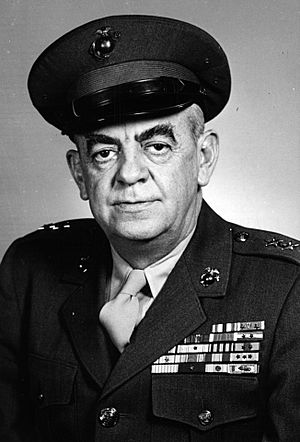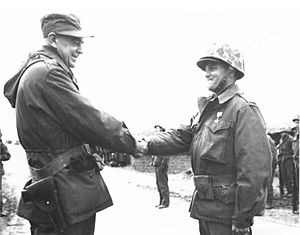Francis M. McAlister facts for kids
Quick facts for kids
Francis Marion McAlister
|
|
|---|---|

MG Francis M. McAlister, USMC
|
|
| Born | March 29, 1905 Houck, Arizona, US |
| Died | September 2, 1965 (aged 60) Blue Mountain, Mississippi, US |
| Buried | |
| Allegiance | |
| Service/ |
|
| Years of service | 1927–1960 |
| Rank | |
| Service number | 0-4264 |
| Commands held | Department of the Pacific Deputy, Fleet Marine Force, Pacific 3rd Marine Division 1st Marine Regiment |
| Battles/wars | Nicaraguan Campaign Yangtze Patrol World War II
|
| Awards | Silver Star Legion of Merit (3) Bronze Star Medal Purple Heart |
Francis Marion McAlister (born March 29, 1905 – died September 2, 1965) was a brave and highly honored officer in the United States Marine Corps. He became a major general, which is a very high rank. McAlister showed great courage during World War II and the Korean War, earning important awards like the Silver Star. He finished his long career leading the Department of the Pacific.
Contents
Becoming a Marine Officer
Francis M. McAlister was born in Houck, Arizona, on March 29, 1905. His family later moved to Mississippi. He went to Mississippi Heights Academy and then spent a year at Mississippi State College.
In 1923, he joined the United States Naval Academy in Annapolis, Maryland. After four years of hard work, he graduated on June 2, 1927. On the same day, he became a second lieutenant in the Marine Corps.
His first training as an officer was at the Basic School in Philadelphia. In January 1928, he joined the 11th Marine Regiment. This group was led by Colonel Robert H. Dunlap.
Early Missions and Adventures
Soon after, McAlister's regiment went to Nicaragua. They helped in operations against rebel forces led by Augusto César Sandino. McAlister did very well there and received the Nicaraguan Presidential Medal of Merit.
After returning to the United States, McAlister served at Marine Corps Base Quantico. He also worked at President Hoover's summer camp for a few years.
In 1932, McAlister was sent to China. He joined the 4th Marine Regiment in Shanghai International Settlement. He was promoted to first lieutenant in November 1933. A month later, he became the commander of the Marine team on the gunboat USS Asheville. This ship protected American lives and property in Chinese waters.
He came back to the U.S. in June 1935 and served at Marine Corps Base Quantico. He was promoted to captain in July 1936. In 1937, he moved to the Headquarters Marine Corps in Washington, D.C.. He worked in the War Plans Section until July 1940.
World War II Heroics
In July 1941, McAlister was promoted to major. He became the commanding officer of the Marine barracks at the Naval Ammunition Depot, Oahu in Hawaii. He was there when the Japanese attacked Pearl Harbor on December 7, 1941.
In 1942, he returned to the U.S. and was promoted to lieutenant colonel. He became the Corps Engineer Officer for the I Marine Amphibious Corps. This group was formed in San Diego, California.
He traveled with his command to the South Pacific Area in October 1942. He fought in the Southern Solomons, Bougainville, and New Georgia. For his excellent service, McAlister received the Legion of Merit with a Combat "V".
During the Battle of Guam in July 1944, he led all engineer units. He did such a great job that he received his second Legion of Merit. McAlister also took part in the Peleliu Operation in September 1944.
His command was chosen to lead all Marine ground units for the Battle of Okinawa in April 1945. McAlister helped plan the mission. He brought together engineer units from the Army, Navy, and Marine Corps. He personally directed the building of bridges and roads, even in bad weather. His units also helped remove land mines left by the Japanese. For his bravery and leadership on Okinawa, McAlister received a Bronze Star Medal with a Combat "V" and a Navy Presidential Unit Citation.
Korean War Service
After World War II, Colonel McAlister returned to the United States in July 1945. He worked in San Francisco, managing engineer supplies for the Marine Corps. He then attended advanced training courses at the Command and General Staff College and the Naval War College.
In August 1949, he became the assistant chief of staff for logistics at Camp Pendleton. In July 1950, he joined the staff of the 1st Marine Division and sailed for Korea. He was the assistant chief of staff for logistics during the Inchon Landing in September.
McAlister worked hard to make sure the division had all the supplies it needed. He gave important information to the commanding general, helping the division succeed against the enemy. He also took part in the Second Battle of Seoul and the Battle of Chosin Reservoir.
In January 1951, McAlister took command of the 1st Marine Regiment. The Chinese Army launched strong attacks near Horseshoe Ridge. McAlister's regiment took defensive positions. During fierce fighting over a key bridge, McAlister was wounded by enemy mortar fire. Even though he was hurt, he refused to leave. He kept leading his men until the enemy forces were pushed back.
McAlister stayed in command until May 1951. For his bravery with the 1st Marines, he received the Silver Star. He also received the Purple Heart for his wounds and two more Navy Presidential Unit Citations.
Later Career and Retirement
After returning to the United States in June 1951, McAlister became the President of the Marine Corps Equipment Board in Quantico, Virginia. His job was to decide if new equipment should be approved for the Marines.
In April 1953, he moved to Hawaii. There, he became the chief of staff for the Fleet Marine Force, Pacific. He was promoted to brigadier general in March 1954.
In August 1954, he went to Washington, D.C.. He worked at the Headquarters Marine Corps as the assistant chief of staff for logistics. In January 1956, he was promoted to major general.
From July 1957 to March 1958, McAlister commanded the 3rd Marine Division in Okinawa. This division was responsible for defending the Far Eastern area.
He then served as deputy commander of the Fleet Marine Force, Pacific in Hawaii. In January 1960, he moved to San Francisco. There, he took on his final role as commanding general of the Department of the Pacific. He oversaw the closing down of this command in July 1960.
Major General Francis M. McAlister retired from the Marine Corps after 33 years of service. He settled in Blue Mountain, Mississippi. He passed away there on September 2, 1965. He is buried at Arlington National Cemetery in Virginia.
Awards and Decorations
Here are the awards and decorations Major General Francis M. McAlister received:
| 1st Row | Silver Star | |||||||||||||||
|---|---|---|---|---|---|---|---|---|---|---|---|---|---|---|---|---|
| 2nd Row | Legion of Merit with two 5⁄16" Gold Stars and Combat "V" | Bronze Star Medal with Combat "V" | Purple Heart | Navy Presidential Unit Citation with two stars | ||||||||||||
| 3rd Row | Marine Corps Expeditionary Medal with two stars | Second Nicaraguan Campaign Medal | American Defense Service Medal with Base Clasp | American Campaign Medal | ||||||||||||
| 4th Row | Asiatic-Pacific Campaign Medal with one 3/16 inch Silver service star | World War II Victory Medal | National Defense Service Medal | Korean Service Medal with three 3/16 inch service stars | ||||||||||||
| 5th Row | United Nations Korea Medal | Nicaraguan Presidential Medal of Merit with Diploma | Korean Ulchi Medal with Star | Republic of Korea Presidential Unit Citation with two Oak Leaf Clusters | ||||||||||||


